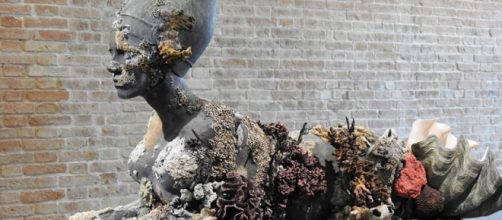It shouldn’t surprise any art lover when art news is reported like a money story, since media coverage on this subject usually get played up that way.
With Damien Hirst in the picture, the tale ought to be about the lost art of originality. But money talks with article lead-ins about his work like this one last week from the Observer:
“A Damien Hirst sculpture was damaged after a Rolls-Royce crashed into the Florida property of billionaire hedge fund investor Steven Tananbaum.” Abundant wealth seemed to be the point.
More of the same
The Daily Mail noted this news in a similar way: “$2.2 billion hedge fund magnate Tananbaum says piece is badly damaged.” And “Tananbaum built GoldenTree Asset Management into a $47 billion hedge fund.” Affluence remains the storyline.
Here’s The Observer again about the damaged art: The incident also caused $10,000 in damages to Tananbaum’s seawall, $100 in damages to their driveway and landscape fence, and $2,000 in damages to the 2018 Rolls-Royce.
Wait, there’s more. This supposed art news also noted that the Tananbaums bought their property in Palm Beach for $26 million in 2011, and that the former owner was founder of the Canadian media company Canwest Global Communications Corp.
Even when the news focuses on the artist, money is still the shiny object. The Sunday Times reported that Hirst is UK’s richest artist. So, if you want news about art, don’t follow the money.
Fake ‘treasure’
The sculpture that was damaged is a painted bronze sphinx-like creature from Hirst’s 2017 show at the Palazzo Grassi in Venice called “Treasures of the Wreck of the Unbelievable.”
These “Treasures” were, in fact, fake artifacts salvaged (wink, wink) from a sunken ship off the coast of East Africa two centuries ago.
It was all make-believe, and in at least one instance, plagiarized.
Victor Ehikhamenor, a Nigerian artist, accused Hirst of copying a 14th-century bronze head of a female unearthed from his land in 1938. It’s not known at this time what other fakes in “Treasures of the Wreck of the Unbelievable” were also plagiarized.
But Hirst has a reputation as a serial knock-off artist.
Examples include his imitation of a 1964 installation by Hans Haacke consisting of a ball keeping a ball high in the air with a current of air.
And Canadian artist Colleen Wolstenholme sued Hirst for stealing one of her designs for a bracelet. This is par. As Frieze magazine reported in 2018, Hirst admitted “All my ideas are stolen anyway.”
Besides collecting Hirst, Tananbaum also purchased three sculptures by Jeff Koons, reportedly paying $13 million.
Koons, a pop artist known for replicating trite things like balloon animals, famously said: “People respond to banal things.”
Art News magazine ranked Tananbaunm on its Top 200 Collectors list. In a statement, he said that he “continues to be a proud collector of works by Koons,” calling him “one of the most important living artists today.”
Are you getting this? While the Medicis, the Italian banking family, gave the world Donatello and Michelangelo with their patronage in the Renaissance, Tananbaum’s patronage of Hirst and Koons may just end up giving art a bad name.
Either that, or Hirst and Koons will go down in history as masters of Post-Renaissance sculpture, and Tananbaum as a latter-day Medici.


